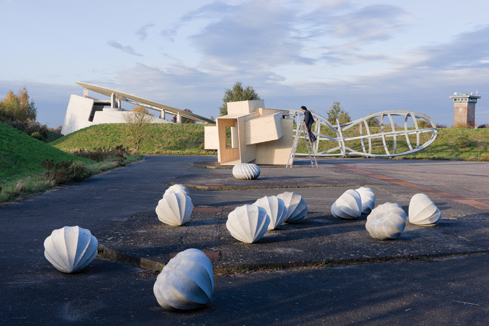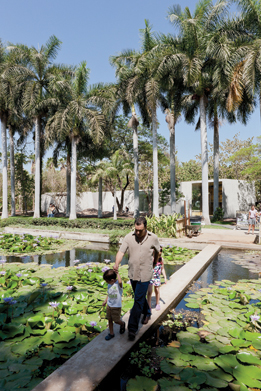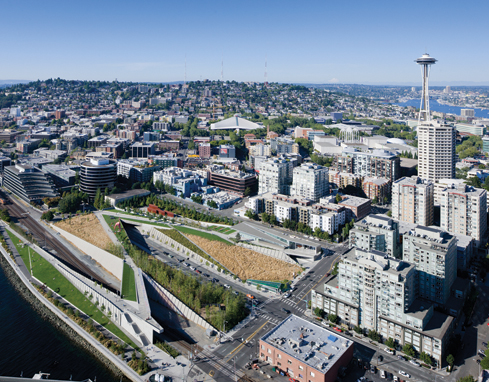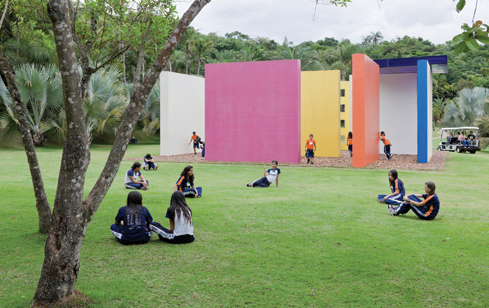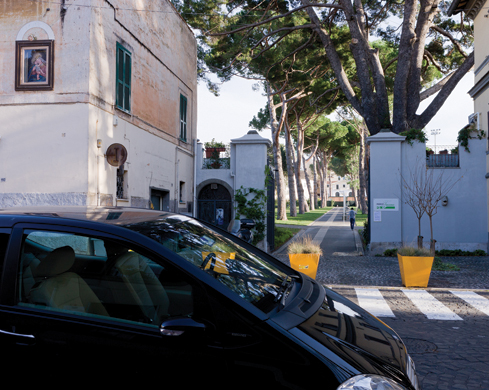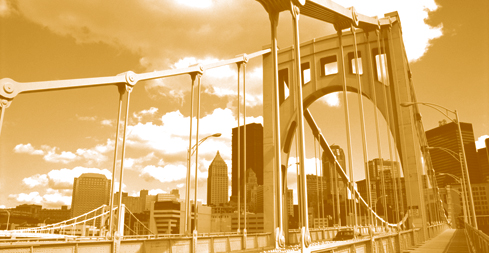 |
||||||||||||||
|
Above: Reflecting pool and large oculus in the Benesse House Oval by Tadao Ando on the island of Naoshima, Japan. Photography by Iwan Baan |
Breaking Out of the Cube
Imagine art spaces that are environmentally friendly, community focused, and literally a breath of fresh air. They exist, and a new Heinz Architectural Center exhibition shows us where. Nestled on separate continents with diverse climates and cultures, the misty Japanese islet of Naoshima, the botanical gardens of Culiacán, Mexico, and the Cold War missile base of Hombroich, Germany, have little in common. But to Raymund Ryan, 21st-century experiments in these disparate landscapes share 2,000- year-old DNA. “Spiritually, they share a legacy that goes back to Hadrian’s Villa,” says Ryan, curator of architecture at Carnegie Museum of Art, referring to the imperial Roman palace that placed the art-loving emperor’s treasures amid fountains, sculptures, and gardens, creating an open-air museum of the finest architecture of the Roman world. “They allow different voices to coexist—those of visitors, as well as architects, artists, and landscape architects.” In White Cube, Green Maze: New Art Landscapes, curated by Ryan and on view in the Heinz Architectural Center through January 13, 2013, the museum immerses visitors in a half-dozen of these experiments, all global examples of what museums could look like in 2050. For nearly a decade, Ryan’s been intrigued by the way institutions have broken out of austere urban galleries— the “cube”—into more relaxed interpretations that sprawl through idiosyncratic landscapes. This first collective look at the international trend brings the museums of the future to Pittsburgh.
The exhibition is big, and its topic red hot in the art world. It’s one of the largest shows ever exhibited in the Heinz Architectural Center’s nearly 20-year history, and travels to Yale University in 2013. It also features the work of not one, but two winners of this year’s prestigious Golden Lion award, a top honor bestowed annually by the International Architectural Exhibition in Venice. Portuguese architect Álvaro Siza Vieira won the award for lifetime achievement; his pavilion at Hombroich— a key element of the open-air art space set within a post-military landscape in northwestern Germany—is featured in White Cube, Green Maze. The exhibition’s vivid and compelling images of visitors exploring all six sites are the work of Iwan Baan, a Dutch photographer also “Lionized” in Venice. Considered a rising star, Baan “shoots buildings the same candid way Diane Arbus shot circus freaks,” said the design blog Co.Design, adding, “his work has a seductive resonance at a time when good architecture is increasingly defined not just by how it looks, but how it works.” Baan’s photographs, installed alongside models, interactive displays, sketches, and historical images, reflect how visitors explore and interact with each of the sites. These new art landscapes—including a group of scenic islands, the edge of a desert, and postwar terrain— have a shared aesthetic, says Ryan. “In most of them, there’s a mix of old and new structures,” he says. “The institution is not a monolith. There’s more than one architect involved, and landscape architects are very important. In general, the sites don’t offer too much interpretation. The key thing, really, is how individuals respond to the work.” Like many museums that sprang up in the 1980s and ’90s, these fresh, inventive landscapes repurpose old industrial sites. But instead of merely creating raw exhibition space—think London’s Tate Modern or Pittsburgh’s own Mattress Factory—they restore ecology and respect topography. The green maze gives equal space to the natural world. So, what does the museum of the future look like? “It will be many things and it will be constantly changing,” says Ryan. A growing art economyTake Instituto Inhotim, a farmstead in a Brazilian mining community. The 700-hectare (2.7-square-mile) nature reserve, which opened to the public in 2006, includes four galleries on four serpentine lakes and boasts extensive plantings designed according to suggestions by famed Brazilian landscape architect Roberto Burle Marx. The expansive grounds invite commissions on a gigantic scale. For Beam Drop Inhotim (2008), Chris Burden and team dropped sculptural steel beams into wet concrete from a height of nearly 150 feet. As part of Doug Aitken’s Sonic Pavilion (2009), geological microphones let visitors listen to otherwise subtle sounds from deep within the earth. Arquitetos Associados, a young firm based in the nearby city of Belo Horizonte, designed many of Inhotim’s recent structures. Ryan says that’s another characteristic of new museums springing up in fastdeveloping countries. “There’s a bit of national pride,” he notes. “I would like to send out a message to the world, a new view of civilization for the 21st century: Use what exists to create what is to be.”
- Soichiro Fukutake, Director of the Benesse Aart Site, in Naoshima
“Today the international art world has reached into almost every country with money and ambition,” he wrote recently for Domus, an international design magazine. “Since the wild success of the Bilbao Guggenheim, every city seems to want a role in this global industry.” High-flying museum patrons maintain homes around the world and follow global art trends, but the newest billionaires often sponsor locales in their home countries. “Very large-scale ideas like these require a special kind of usable landscape,” says Ryan—expansive spreads often found in less-developed regions.
Global tastes make global reputations for artists. The work of American artists James Turrell and Dan Graham is featured at both Benesse Art Site Naoshima and the Jardín Botánico in Culiacán, Mexico. Best known for her dense patterns of polka dots, artist Yayoi Kusama created works for Naoshima in her native country as well as Inhotim in Brazil. And Tadao Ando—the architect Ryan describes as a “pugnacious, extraordinary former boxer”—has designed “interventions” at Hombroich in Germany as well as designing Naoshima, his masterwork. A global mindset is also the reason that these far-flung venues frequently offer elegant guest housing or hotels onsite. To make a pilgrimage to Naoshima, for example, Ryan had to travel by several trains and roughly an hour by ferry from Honshu to the tiny fishing villages where individual artists have created art houses from abandoned dwellings. The museum incorporates a hotel and several guesthouses. In addition to underground museums and cliffside courtyards, the Benesse Art Site also includes an abandoned copper refinery on the island of Inujima, an hour by boat from Naoshima. Here, architect Hiroshi Sambuichi memorialized the site by reusing its brick walls and smokestack. His underground passageway, leading to elements of a traditional home suspended in the industrial space, is represented in the exhibition by a model.
With wide-open physical space and less pressure to create frequent temporary exhibitions, these remarkable sites encourage expressive new forms. “It’s a looser fit,” says Ryan. “In general, the sites don’t offer too much interpretation. The key thing, really, is how individuals respond to the work.”
- Raymund Ryan, Curator of White Cube, Green MazeOf the communityRyan, a native Irishman, points out that public access to art is particularly important to the tiny communities that host these emerging museums. Not only do they provide much-needed employment, but they encourage interest in regional ecology and offer education programs that engage local residents. Tatiana Bilbao, the young Mexican architect leading work on the Jardín Botánico in Culiacán, has placed education buildings along a lacework of paths inspired by sunlight, moving shadows, and tree branches. Designed by Mexico City’s TOA (Taller de Operaciones Ambientales), the park includes bamboo glade, a tropical rainforest, a food forest, a xeriscape (a desert-like landscape), and a palm garden. As Ryan notes in the exhibition catalog, the garden suggests “a new form of public space, as witnessed by the many quinceañeras, girls in ball gowns celebrating their fifteenth birthdays.” And as visitors wander the natural setting, discovering installations like an old Volkswagen Beetle crashed into a living tree, they seem to recover a sense of delight. As Iwan Baan told an audience at the exhibition opening in September, “People are just out of their minds…It’s a completely different mindset” from a traditional museum visit. The reused industrial sites and restored natural ecologies of these new art landscapes also show a new respect for sustainability. In several cases, the museum sites even incorporate residential housing, strengthening the connection between institution and neighborhood. At Hombroich, a former German NATO base, Raimund Abraham’s soon-to-be completed House for Musicians provides musicians with apartments, common space, a library, and a room for public events. Other proposals include energy-efficient courtyard homes.
The Grand Traiano Art Complex, now being planned only a few miles from Hadrian’s Villa outside of Rome, aims to reconnect the city’s heritage with its contemporary art scene. For its planned home of Grottaferrata, the Los Angeles team of Sharon Johnston and Mark Lee created a master plan to rejuvenate the aging hill town. Around its landmark structures— a 1,000-year-old monastery, a derelict villa, and a popular sports field—the team envisions artist studio spaces and new community housing. The pair is also redeveloping a winery at Poggio Golo in the Montepulciano region north of Rome for the same clients. At that site, three connected wings—one entrenched in the hill, the other two sloping to bracket a patio— extend a vista to the surrounding countryside. The site model on view in the exhibition includes the candy-colored monoliths that French artist Daniel Buren proposes to erect in a reflecting pool surrounded by mirrored glass. In the Pacific Northwest, the Olympic Sculpture Park appropriates a particularly American landscape: the freeways that run alongside Puget Sound through downtown. The project of the Seattle Art Museum repurposes an oil refinery site to connect residents to the water’s edge and restore the aquatic life of the inlet. Opened in 2006, the park suggests a healthy balance between human activity, art, and nature along zigzagging hillside paths. One major installation is Mark Dion’s Neukom Vivarium (2003–2004). Housed in a greenhouse, a decaying 60-foot hemlock serves as a nurse log, supporting the rainforest plants indigenous to the region. Whether the materials at hand are rotting trees, crumbling villas, or abandoned fisherman’s homes, the visions expressed in White Cube, Green Maze suggest a sustainable architectural ethos in living communities. Soichiro Fukutake, director of the Benesse Art Site, says the shared message is simple: “I would like to send out a message to the world, a new view of civilization for the 21st century: Use what exists to create what is to be.”
Transforming the Pittsburgh Landscape
New York has the High Line. Texas has Marfa. What one-of-a-kind venue could Pittsburgh offer as a museum of the future? CARNEGIE magazine asked local creative thinkers for their thoughts. After working for several years on White Cube, Green Maze, curator of architecture Raymund Ryan thinks tucking small sites among the city’s residential hills and valleys has potential. “Some buildings in White Cube, Green Maze are bravura works of architecture by leading contemporary architects,” he says. “Other structures in the exhibition are much smaller, inserted into the fabric of existing neighborhoods or existing buildings radically re-presented by designers and artists. Could more of these modest buildings and lots be used for art, and strengthen the urban fabric in a way that is uniquely Pittsburgh?” In fact, it’s already happening. One local art collector and advocate, Evan Mirapaul, has already commissioned artist Thorsten Brinkmann to create an “art house” on Troy Hill, where Mirapaul lives. The “germinal idea,” Mirapaul says, stemmed from his visit to the Benesse site in 2007. “I thought, what’s stopping other people from doing this? It’s not that crazy to do,” says Mirapaul. “Pittsburgh and a Japanese fishing village aren’t exactly apples to apples, but both are places where people used to do things they can’t do anymore, so the nature of place is going to change.” Brinkmann’s project in a house purchased from the city’s Urban Redevelopment Authority uses “installations, sculpture, and photography, all using reclamation in ways that relate to each other,” says Mirapaul. It will be completed in mid-2013 and open to the public by appointment. As at Benesse, Mirapaul says it will also be a short-term residence for artists and other guests. He hopes that the project will grow to include several other houses in the neighborhood. Design Pittsburgh, an annual competition sponsored by the local chapter of the American Institute of Architects, asked this year’s entrants to create new uses for the Fort Wayne Bridge. Several architects proposed using it as an art space. Carnegie Mellon University architecture professor Rami el Samahy says the railroad bridge that skirts the convention center on its way across the Allegheny River would be ideal. “Celebrating [the city’s interaction with infrastructure and topography] seems crucial, especially in this era when so much of our infrastructure languishes, badly in need of repair. Siting a new museum on the lower deck of the bridge would do just that: Both in the city and outside it, hovering above the Allegheny while connecting Downtown to the North Side, I see poetic potential for this elegant centenarian.” A forgotten bridge at the foot of Highland Park intrigues landscape architect Kary Arimoto-Mercer. The Pennsylvania Railroad Brilliant Viaduct along Washington Boulevard used to span Silver Lake, a river inlet; now industrial buildings and a carwash have replaced the lake. “Imagine a light museum through this bridge over a cultural brownfield—a lake of illumination projected to and from the stone viaduct by diverse artists such as James Turrell, Krzysztof Wodiczko, and Lucette de Rugy,” says Arimoto-Mercer. Don Carter, director of CMU’s Remaking Cities Institute and consulting principal of Urban Design Associates, says “abandoned strip mines offer a great opportunity for a fusion of art and landscape, overlaid with industrial history. What if we turned James Turrell, Walter de Maria, Christo, and other landform artists loose on one of these dramatic sites? Their work could be combined with industrial artifacts (steam shovels, dump trucks, and conveyor belts) and large-scale metal sculptures by artists like Richard Serra, Mark di Suvero, and John Chamberlain.” Sculptor Dee Briggs, who like Thorsten Brinkmann was a contributor to The Warhol’s recent Factory Direct: Pittsburgh experiment, says the preserved Carrie Furnace site— previously explored by artists like Tim Kaulen—would be a natural art campus. “Neighbor to a thriving art community in Braddock, the Carrie Furnace could be treated as the permanent collection,” notes Briggs. “The site would inspire a lifetime of provocative contemporary art across many creative disciplines.”
|
|||||||||||||
Our Place in Space · Reimagining Home · Southern Exposure · Directors' Note · NewsWorthy · Face Time: Tina Kukielski · Artistic License: Hacking Reality · Science & Nature: Going Buggy · Field Trip: Where in the World is Carnegie Museums? · The Big Picture
 |
Copyright © 2017 CARNEGIE Magazine. All rights reserved. |

